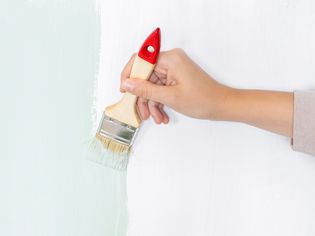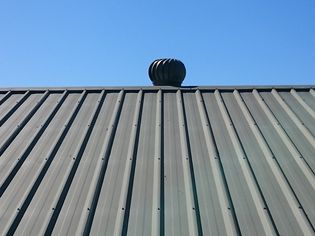How to Whitewash a Stone Fireplace for an Easy DIY Makeover
Want a fresh look for your stone fireplace without the expense of hiring a mason? A coat or two of whitewash can do the trick.
While regular white paint—or any color, for that matter—would also work, the opaque coverage will transform the color and look of the stone. Whitewash, on the other hand, provides a sheer tint that retains the stone’s gorgeous texture.
Let’s take a closer look at how to whitewash a stone fireplace. This DIY-friendly method can elevate a stone fireplace to become the focal point of any room.
What Is Whitewash?
Whitewash is simply white paint diluted with water. It's a wash of translucent color that, when applied applied to a fireplace, provides a fresh, clean look to the stone.
Yes, you can add water to any paint color, but white is the traditional color to use, hence the name. It’s as easy as mixing up a 1-to-1 ratio of paint and water, though depending on the coverage you’re going for with your stone fireplace, you might want a heavier pour on the paint or the water.
How to Whitewash a Stone Fireplace
Whitewashing a fireplace is a project that can be completed in an afternoon. Here’s how to do it.
1. Clean the Fireplace
Your fireplace cleaning method will vary depending on whether it's nonworking or working.
- Nonworking fireplaces just need a good dusting or vacuuming with a brush attachment.
- For fireplaces used occasionally, cover the floor with a drop cloth. Fill a gallon bucket with hot water mixed with about 1/4 cup of dish soap. Stir to create some suds, then scrub the fireplace down from top to bottom. Clean off any remaining soap or soot by going back with a wet rag—use fresh, cold water this time—and wipe the stone down.
- To clean off stuck-on soot, you might need to use a heavy-duty cleanser like trisodium phosphate, or TSP. Use protective gloves and goggles and read the instructions carefully before using.
2. Prep the Area for Whitewashing
Diluted paint is still paint, so keep that drop cloth on the floor and mark off the trim with painter’s tape to avoid spattering anything but the stone fireplace
3. Mix the Whitewash
Whitewash is a 1:1 combination of paint and water that you can mix in a measuring cup for smaller projects. For stone, opt for a latex or chalk-based paint—and make sure it's heat resistant if you're painting an active fireplace.
Choose a container big enough to pour and stir enough whitewash mixture for your fireplace; a gallon bucket should be just fine.
Err on the side of caution and make a bit more whitewash than you think you’ll need so that the coverage remains consistent.
4. Paint on the Whitewash
With a paintbrush, apply whitewash on a small, hidden spot first to test the coverage—you might need to add more water or paint depending on the look you want.
Once you're satisfied with the coverage, start painting from the top to bottom so you can paint over drips as you go. Keep a rag or cloth handy to clean up any excess.
5. Let It Dry
The fireplace will dry to the touch fairly quickly, but go ahead and give it a full 24 hours.
Tips for Maintaining a Whitewashed Stone Fireplace
When the job is done well, whitewash can last between 20 and 30 years. Here’s how to make your whitewashed fireplace look good for as long as possible:
- Choose quality paint. Just like good ingredients make for better cooking, good supplies make for better home improvement projects. You don’t have to go top of the line but do choose a brand of paint known for its longevity. (Make it heat-resistant if you plan to use your fireplace.)
- Seal it. It’s not a mandatory step, but a sealant can protect the whitewashed finish against scuffs, scratches, and other damage.
- Keep it clean between uses. Soot and creosote buildup can put a damper on a gorgeous fireplace. If yours is an active one, make sure to clear out ashes regularly between uses. Otherwise, you can get away with regular dusting or vacuuming with a brush attachment.
- What kind of paint do you use to whitewash a stone fireplace?
To whitewash a stone fireplace use latex or chalk-based paints, which are best for stone and other masonry, like brick. While any paint can crack or chip over time, heat-resistant paint will maintain the finish on a working fireplace for far longer.
What is the difference between limewash and whitewash?Limewash is a chalky white mixture consisting mainly of water and lime, which comes from limestone. Whitewash is a 50/50 mixture of paint and water. When When limewash is applied to stone, it sinks into the porous surface so that it won’t alter the texture of the stone. But when limewash is applied to stone, it remains on top of the stone without penetrating the surface and dries to a sheer finish.
RECOMMENDED NEWS
 PAINTING
PAINTINGCan I Use Exterior Paint Inside? Here's Everything You Need to Know
Interior paint is used for indoor areas like walls and ceilings, while exterior paint is used on su...
 SMALL-SPACES
SMALL-SPACES15 Simple Small Living Room Ideas for Minimalist Style
Just because you have a small living room does not mean you have to skimp on style when it comes to...
 SMALL-SPACES
SMALL-SPACESWhat Is a Kitchenette? The Difference Between a Kitchen and a Kitchenette
Kitchenettes are miniature versions of full-size kitchens, but don't let their tiny footprint confu...
 INTERIOR-REMODEL-AND-REPAIR
INTERIOR-REMODEL-AND-REPAIR10 Living Room Remodeling Ideas That Pay Off
Living room remodeling pays off in so many ways. To start, it's one of the easier, less demanding r...
 INTERIOR-REMODEL-AND-REPAIR
INTERIOR-REMODEL-AND-REPAIRAttic Fan: What Are the Pros and Cons of Installing One?
Keeping a house cool and well-ventilated is important for its residents' comfort and the house's he...
 INTERIOR-REMODEL-AND-REPAIR
INTERIOR-REMODEL-AND-REPAIR3 Common Renovation Mistakes Designers Really Hate (and How to Avoid Them)
Embarking on a home renovation can stir up a flurry of emotions. The process is exciting, daunting,...






Comments on "How to Whitewash a Stone Fireplace for an Easy DIY Makeover" :